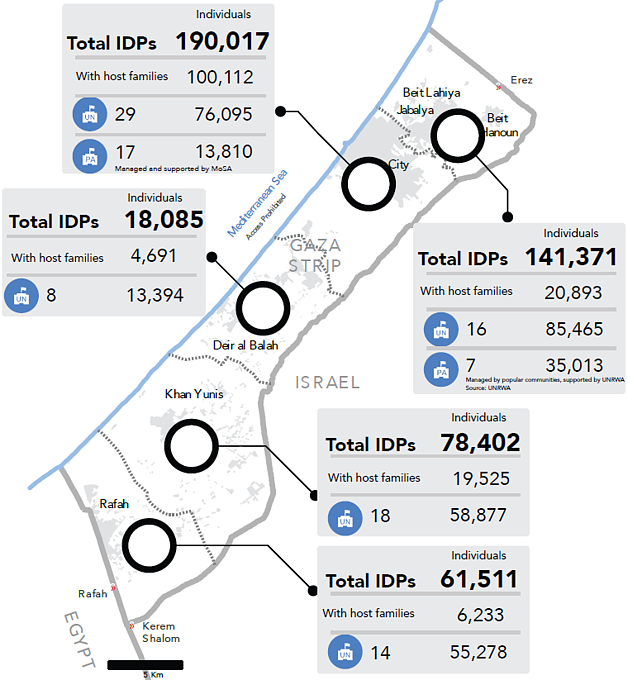The Gaza Strip: Internal Displacement in the Context of the 2014 Hostilities | July 2015
Key facts
- 12,620 housing units were totally destroyed over the course of the 2014 summer hostilities and 6,455 were severely damaged, displacing 17,670 families or about 100,000 persons.
- Almost one year after start of hostilities, not a single totally destroyed home has been rebuilt in Gaza; initial steps on the ground are expected to start over the second half of 2015.
- Donors have recently disbursed a total of US$ 125 million for the reconstruction of approximately 20% of the totally destroyed homes (Shelter Cluster, May 2015).
- Almost 150,000 additional housing units sustained various degrees of damage but remained inhabitable; about half of the affected families have purchased construction materials under the Gaza Reconstruction Mechanism (GRM).
- At the height of the conflict, an estimated 485,000 people – 28% of the population – were displaced, including almost 300,000 in 90 UNRWA-operated emergency shelters.
- Since the ceasefire of 26 August 2014, IDPs hosted in UNRWA collective centres have been gradually leaving for alternative accommodation, with the last centres shutting down in June 2015.
- Less than 1% of the construction materials required to rebuild and repair houses destroyed and damaged during the 2014 and previous hostilities, and to address natural population growth, have so far entered Gaza (Shelter Cluster, June 2015).
- 87% of displaced families received at least one cash assistance allotment, consisting of about $US 200-250 per month for a period of 4-6 months, as well as a US$ 500 one-off reintegration package, to replace lost household goods.
- The summer 2014 hostilities resulted in the largest displacement recorded in Gaza since 1967. The massive scope of destruction of houses can be attributed to practices adopted in the conduct of hostilities, including Israeli airstrikes targeting residential buildings, Israel’s use of artillery barrages in residential neighborhoods, and the Palestinian armed factions’ practice of launching attacks nearby, or from within, heavily populated areas. Multiple incidents in the context of these practices have raised concerns about respect for the principles of distinction, proportionality and precaution in attack under international humanitarian law (IHL), and may amount to war crimes.[*]
- The living conditions of IDPs, currently accommodated with host families, in rented apartments, prefabricated units, tents and makeshift shelters, or in the rubble of their previous homes, raise a range of protection concerns. These include limited access to basic services, lack of privacy, genderbased violence, tensions with host communities, risks due to unexploded ordnance, and exposure to weather extremes. This has exacerbated the vulnerability of certain groups, particularly children, women-headed households, persons with disabilities, the elderly, and those with chronic diseases.
- Information gaps regarding the exact location of IDPs and their living conditions at the household level are an ongoing challenge, impeding the ability to respond to existing and emerging needs. A profiling exercise aimed at assessing the specific needs and vulnerabilities of IDPs and hosting communities is planned to be launched in August 2015, involving multiple humanitarian agencies and local authorities coordinated by OCHA.
- Almost one year after the hostilities, there has been little progress in the reconstruction of houses totally destroyed, prolonging the suffering of IDPs. Key reasons include the inability of the Palestinian Government of National Consensus to assume effective government functions in Gaza, due to the ongoing internal divide; Israel’s longstanding restrictions on the import of building materials defined as “dual use items”; and the slow pace of disbursement of pledges made by member states for reconstruction. This is adding to the general frustration of the population following years of longstanding movement restrictions and rising unemployment and poverty.
- Large-scale reconstruction within a reasonable time period, allowing for a durable solution to the plight of IDPs, including those from previous conflicts, is essential to enable the realization of their human rights, and can contribute to avoid an environment conducive to a new round of violence. Such a solution requires a full lifting of restrictions on the import of building materials, alongside the ability of the relevant Palestinian authorities to discharge their government functions effectively, and a strong and timely mobilization of resources by the international community.

1. Shelter Cluster Factsheet, March 2015. | 2. Shelter Sector Gaza, Shelter Advocacy Fact Sheet, 5, March 2013. | 3. UNDP, One Year After, Gaza Early Recovery and Reconstruction Needs Assessment, p.49.
[*] Report of the detailed findings of the independent commission of inquiry established pursuant to Human Rights Council resolution S-21/1.










